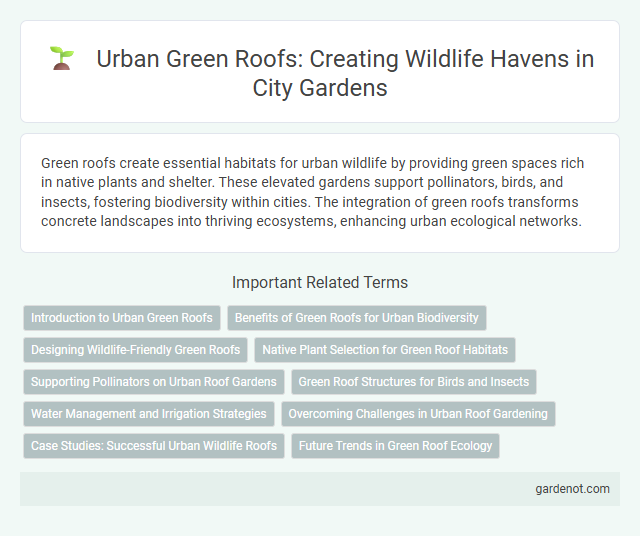Green roofs create essential habitats for urban wildlife by providing green spaces rich in native plants and shelter. These elevated gardens support pollinators, birds, and insects, fostering biodiversity within cities. The integration of green roofs transforms concrete landscapes into thriving ecosystems, enhancing urban ecological networks.
Introduction to Urban Green Roofs
Urban green roofs serve as vital habitats for diverse wildlife species, supporting urban biodiversity by providing food, shelter, and breeding grounds. These engineered ecosystems mitigate heat island effects and improve air quality, creating conducive environments for birds, insects, and small mammals. Integrating native plants enhances ecological value and promotes sustainable urban wildlife corridors.
Benefits of Green Roofs for Urban Biodiversity
Green roofs create vital habitats that support diverse urban wildlife, including pollinators, birds, and beneficial insects, by offering food sources and shelter in densely built environments. These vegetated rooftops improve ecological connectivity in cities, fostering species movement and genetic exchange between isolated green spaces. Enhancing urban biodiversity with green roofs contributes to more resilient ecosystems and healthier urban environments.
Designing Wildlife-Friendly Green Roofs
Designing wildlife-friendly green roofs involves selecting native plant species that provide food and shelter for urban fauna, supporting biodiversity in city landscapes. Incorporating structural diversity through varied vegetation heights and features like logs or rocks creates habitats for insects, birds, and small mammals. Proper irrigation and avoidance of pesticides ensure a sustainable and thriving ecosystem that benefits urban wildlife.
Native Plant Selection for Green Roof Habitats
Native plant selection for green roof habitats enhances urban wildlife by providing food, shelter, and breeding grounds tailored to local species. These plants support pollinators such as bees and butterflies, while also attracting birds and beneficial insects, creating a balanced ecosystem in the cityscape. Incorporating drought-tolerant and hardy native species ensures resilience and long-term sustainability of green roof habitats in urban environments.
Supporting Pollinators on Urban Roof Gardens
Urban roof gardens act as critical habitats supporting pollinators such as bees, butterflies, and hummingbirds by providing diverse floral resources and nesting sites. Incorporating native flowering plants and continuous blooming cycles enhances food availability, fostering pollinator health and biodiversity. These green roofs contribute to urban wildlife corridors, promoting ecological connectivity in densely built environments.
Green Roof Structures for Birds and Insects
Green roof structures provide essential habitats for urban wildlife, supporting diverse bird and insect populations by offering nesting sites, shelter, and food sources within city environments. These green roofs incorporate native plants and layered substrates that attract pollinators like bees and butterflies while also facilitating bird species such as sparrows and finches. Designing green roofs with ecological considerations enhances urban biodiversity and helps sustain wildlife resilience amid growing metropolitan development.
Water Management and Irrigation Strategies
Green roofs create vital urban wildlife havens by integrating advanced water management and irrigation strategies that mimic natural hydrological cycles. Rainwater retention systems and drip irrigation optimize moisture levels, supporting diverse plant species and attracting pollinators and birds. These sustainable water solutions reduce runoff, enhance habitat quality, and promote biodiversity within densely built environments.
Overcoming Challenges in Urban Roof Gardening
Urban roof gardening faces challenges such as limited space, harsh microclimates, and pollution exposure that impact the success of green roofs as wildlife havens. Innovative solutions like selecting native, drought-resistant plants, creating layered vegetation, and installing water features can support biodiversity by providing shelter and food sources for birds, insects, and pollinators. Incorporating structural elements like nesting boxes or insect hotels further enhances habitat complexity, overcoming barriers to flourishing urban wildlife ecosystems.
Case Studies: Successful Urban Wildlife Roofs
Green roofs in urban areas create thriving habitats for diverse wildlife, as demonstrated by the Chicago City Hall rooftop, which supports over 18 species of native plants and numerous pollinators. The California Academy of Sciences' living roof integrates over 1.7 million native plants, attracting birds, butterflies, and beneficial insects, enhancing local biodiversity. These case studies highlight green roofs as vital urban wildlife havens, promoting ecological balance and environmental resilience.
Future Trends in Green Roof Ecology
Future trends in green roof ecology emphasize creating urban wildlife havens by integrating native plant species and habitat features that support pollinators, birds, and insects. Advances in green roof technology promote biodiversity by enhancing microclimates and soil health tailored to specific urban environments. Research highlights the potential for multifunctional green roofs to serve as critical ecological corridors, fostering connectivity between fragmented urban habitats.
Urban wildlife haven Infographic

 gardenot.com
gardenot.com